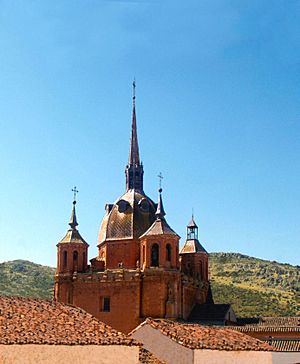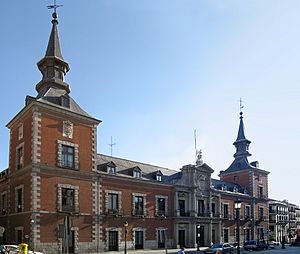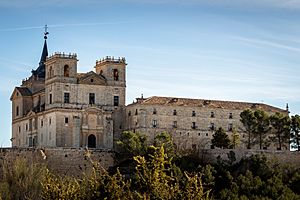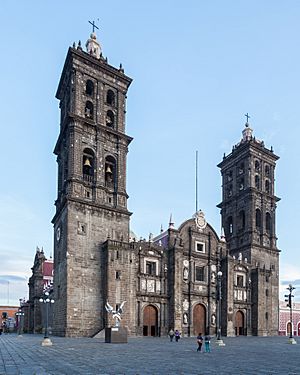Herrerian style facts for kids
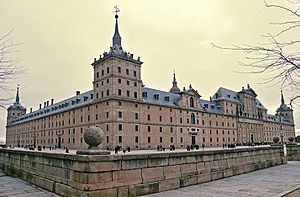
The Herrerian style (also called estilo herreriano) is a special type of architecture that became popular in Spain during the late 1500s. It was named after a famous architect, Juan de Herrera. This style was used during the time of King Philip II (1556–1598). It was the last part of the Spanish Renaissance architecture.
Before the Herrerian style, Spanish buildings often had lots of fancy decorations, like the Plateresque style. Then came a simpler style called Purism. Finally, the Herrerian style made buildings even more simple and focused on clear shapes.
This style started with the building of the huge Monastery of El Escorial near Madrid. The first architect, Juan Bautista de Toledo, began the work. But after he passed away, Juan de Herrera took over and changed the plans, making the style famous.
Besides Herrera, another important architect of this style was Francisco de Mora. He was Herrera's student and designed buildings like the Lerma Ducal Palace.
Contents
What Makes Herrerian Style Unique?
Herrerian architecture is known for being very neat and orderly. It uses simple geometric shapes and has a strong mathematical feel. Buildings in this style often look solid and have very little decoration. That is why it was sometimes called the "unornamented style" (estilo desornamentado). People also call it the "Escorial style" because the Monastery of El Escorial is the best example.
Key Features of Herrerian Buildings
Herrerian buildings often look very flat and wide. This is because they use balanced, often cube-like shapes arranged in a symmetrical way. They usually have wooden roofs covered with dark slate. Many buildings also have tall, thin towers on the sides. These towers often end in pointed, pyramid-like tops, known as "Madrid-style spires." These spires add a touch of height and grandeur while keeping the symmetrical look.
Sometimes, the style focuses more on making buildings look big and strong. This is common in churches, which might have large fronts, square towers, and heavy buttresses (supports).
Most Herrerian buildings are very large. They look impressive in their surroundings and have a serious, grand appearance.
Simple Decorations
When it comes to decorations, Herrerian buildings keep it very simple. They might use basic geometric shapes like spheres and pyramids. This simple, plain look was partly a response to the religious changes happening in Europe at the time, like the rise of Protestantism. It followed the ideas from the Council of Trent, which encouraged a more serious and less flashy style.
How the Style Grew
The Herrerian style became the official architecture for the Habsburg kings of Spain, starting with King Philip II. The building of the Monastery of El Escorial (1563–1584) was a huge project that helped spread the style. Also, Juan de Herrera was made the "Inspector of Monuments" for the Crown in 1579, which helped the style spread even more.
Spread in Spain
The style first became popular around the Sierra de Guadarrama mountains, close to the El Escorial Monastery. This happened in two ways:
- Royal Projects: The King's family paid for new buildings and roads. For example, the Puente Nuevo bridge in Galapagar was built. There were also royal houses for King Philip II when he traveled between Madrid and El Escorial. In El Escorial town, the Crown helped develop the town and build the Church of San Bernabé, designed by Francisco de Mora.
- Local Projects: The King also encouraged towns to update their main public and religious buildings. This is why churches in places like Valdemorillo and Navalagamella, which were originally medieval, now look Herrerian.
Herrerian Style Across the World
The Herrerian style quickly spread throughout Spain and even to America. Some famous examples include:
- The Cathedral of Valladolid and the Puente de Segovia bridge in Madrid, both designed by Juan de Herrera.
- The church of the Monasterio de Uclés in Cuenca Province, by Francisco de Mora.
- The Church of San Sebastián in Segovia Province.
- The College of Our Lady of Antigua in Lugo Province.
A very important building was the Ducal Palace of Lerma in Burgos Province, started by Francisco de Mora in 1601. This palace helped mix the Herrerian style with the new Baroque architecture that was starting to appear. It also set a new standard for palace design that was copied throughout the 1600s.
Many public buildings in Madrid during the reigns of Philip III and Philip IV followed the style of the Lerma Palace. Examples include the Palace of the Councils, the Santa Cruz Palace, and the Casa de la Villa. These buildings have Baroque elements but still show strong Herrerian influences. The unique "Madrid-style spire" with its slate roof also became very popular. Many buildings from the 16th and 17th centuries, especially church bell towers and domes, adopted this feature.
In the 1700s and 1800s, the Herrerian style became less popular. However, it saw a small comeback in the 1900s, especially during the time of Francisco Franco. For example, the Plaza de la Moncloa in Madrid, with the Air Force headquarters, shows this return to Herrerian architecture.
See also
 In Spanish: Arquitectura herreriana para niños
In Spanish: Arquitectura herreriana para niños
- Royal Alcazar of Madrid, a defunct notable Herrerian royal castle
- El Madrid de los Austrias
- Imperial Route of the Community of Madrid


